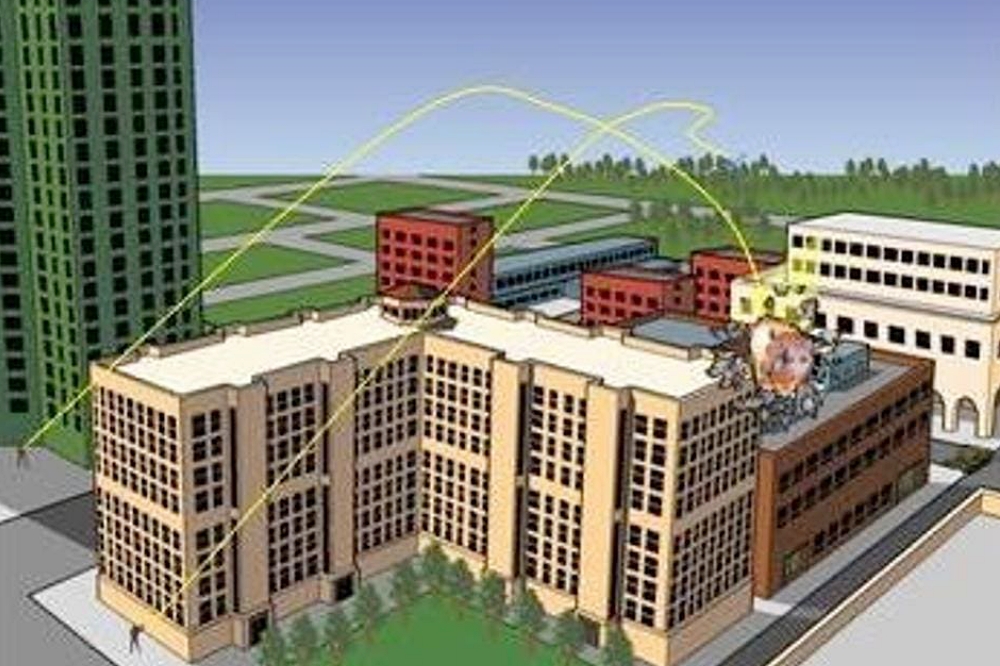German developers are demonstrating a new drone in Ukraine called HCX which is immune to radio -frequency jamming and detection because it communicates with its operator via a fiber-optic cable.
Small drones have become ubiquitous in this conflict; Ukraine plans to build more than a million this year. But radio-frequency jamming has also stepped up. In a recent speech, French Army Chief of Staff Gen. Pierre Schill claimed that 75% of drones in Ukraine were taken down by electronic warfare breaking the link between drone and operator, suggesting that the reign of the drone could soon be over.
The HCX made by from HIGHCAT, based in Konstanz, Germany, unspools a fiber-optic cable as it flies. This supplies a high-bandwidth data link immune to radio interference. And because there are no radio emissions, neither the operator nor the drone can be located and targeted.
Flying By Fiber
HIGHCAT co-founder Jan Hartmann explains that the cable only exerts about 8 ounces/ 250 grams of force on the drone, so it does not obstruct flight. It has a flight range of up to 12 miles / 20 kilometers. The drone drops cable behind it like a trail of breadcrumbs, so there is no tangling.
“The fiber is pretty strong – flying over trees and water is no problem,” says Hartmann. “Flying in circles is also fine, and the drone can even fly backwards.”
Previous efforts to develop fiber-optic guidance for drones include DARPA’s Close Combat Lethal Recon (CCLR) of the early 2000’s and a Russian drone captured in Ukraine in March. DARPA eventually dropped the fiber control for a radio and CCLR evolved into the SwitchBlade used by US forces. The Russian drone appears to have been an experimental model and only one example has been seen. Some missiles like TOW use guidance via copper wires but these only carry the control signals and do not transmit video.
((There are also tethered drones with a thick cable transmitting power as well as data, but these are limited to hovering above their base station so are basically static observation towers or platforms for electronic warfare)).
Fiber-control has attracted little interest in the past because radio control works so well and interference was not seen as a problem. But in the intense electronic warfare environment of Ukraine, drone makers have to keep shifting operating frequency because the jamming is so intense. Some combat vehicles now carry multiple roof-mounted drone jammers to create a protective ‘bubble’ hundreds of metres across, while both sides now deploy large number of backpack jammers and anti-drone guns, rifle-like weapons which fire a narrow beam of radio waves.
“The technology was designed with the frontlines in mind, in particular, the current developments in Ukraine,” says Hartmann. “We wanted to create a COTS [Commercial Off The Shelf] system that wasn’t jammable by enemy combatants.”
The Challenge of Unspooling
The resulting HCX drone can fly unhindered in the most intense electronic warfare. But getting it to work has not been simple.
“The fiber must not be too easy to unwind, otherwise it will pull itself out due to the downwash of the propeller,” says Hartmann. “Furthermore, the glass fiber must not twist during unwinding, otherwise it will break. The Fly-By-Fiber technology uses specially wound and coated glass fiber spools, which are installed in a special winding technique.”
Fiber-optic guidance does come with a weight penalty compared to radio. The maximum payload of the HCX is 5 kilos / 11 pounds, but some of this is taken up by the fiber optic cable spool. Six miles of cable weighs about three pounds, so a drone with a full 12-mile reel only has about five pounds of payload. However, Hartmann notes that this is still more than enough for a 10x optical zoom camera with thermal imaging. Or a decent-sized munition.
Other benefits include a standard 1000Base-T connection with a speed of 1,000 Megabits per second, roughly a hundred times as much as a radio link, ensuring a clear high-definition view throughout the flight. And while other FPV drones lose their connection when they drop low below the radio horizon in the final dive on a target, a fiber-optic drone will maintain communication.

DARPA’s Close Combat Lethal Recon drone was a fiber-optic guided loitering munition for urban combat DARPA
In principle this type of drone can also explore inside buildings or down tunnels. Radio bandwidth limitations mean that only a few radio-controlled drones can operate in one area, but multiple HCX drones can fly without interference.
HCX could also act as a fiber-optic cable later, establishing high-capacity links to fighting positions which can be used when other means of communication are jammed.
Drones of the Future
The other technology being developed as a counter to jamming is autonomy, with AI-enabled drones completing missions after losing communication with the operator. Fiber optic communications has the advantage of being able to relay back video imagery in real time, whereas an autonomous drone has to wait until it could get back into radio range to download data.
Hartmann says HIGHCAT is talking to a number of potential customers/sponsors but is unable to give details. Later this month a team is going to Ukraine to demonstrate HCX and show how well it works in realistic conditions. The plan is to test it in a controlled environment against a jammer, but the drones may end up much closer to actual Russian jammers.
“Should the units want to test it on the frontline, this is possible,” says Hartmann.
HIGHCAT aim to have HCX ready for production in November, and could then produce 3,000 units a month with their industrial partners ODM GmbH. If HCX is successful then others are likely to follow suit, and drones with fiber-optic capability are likely to proliferate. Which is bad news on anyone relying on jammers to protect them.
Source: Forbes


